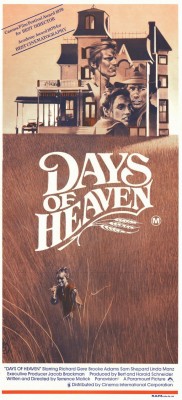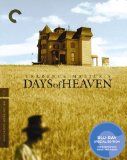| Reviews & Columns |
|
Reviews DVD TV on DVD Blu-ray 4K UHD International DVDs In Theaters Reviews by Studio Video Games Features Collector Series DVDs Easter Egg Database Interviews DVD Talk Radio Feature Articles Columns Anime Talk DVD Savant Horror DVDs The M.O.D. Squad Art House HD Talk Silent DVD
|
DVD Talk Forum |
|
|
| Resources |
|
DVD Price Search Customer Service #'s RCE Info Links |
|
Columns
|
|
|
Days of Heaven
A truly unique American film, Days of Heaven (1978) was the second feature written and directed by the famously reclusive Terrence Malick, who previous to this made the superb Badlands (1973) but following Days of Heaven all but vanished - he wouldn't direct another movie for 20 years.
The film defies conventional description. Its slight story of a three migrant workers who become entangled in the personal life of a wealthy but dying wheat farmer is much less important than its other interests, which are primarily visual and in evoking a time and place. Various critics have described it as an existential visual poem drawing on the visual style of Andrew Wyeth and other painters but it's also almost like a time portal into a harsher, early-industrial age when the working poor were veritable slaves, their dreary, hopeless lives contrasted with the exquisitely beautiful landscapes of its Texas Panhandle setting (though the film was in fact shot in Alberta, Canada).
Asked to come up with a list of the 10 or 20 movies most ideally suited to high-definition presentation, Days of Heaven would surely be one of them. It's an astoundingly beautiful film; even critics who disliked it for other reasons were unanimous in their unreserved praise for its cinematography, a collaborative effort by director Malick and cinematographers Néstor Almendros and Haskell Wexler, second unit DP Paul Ryan, camera operator John Bailey, and a few others. The disc includes some fine extras and a big fat booklet.
In 1916, hotheaded steel mill worker Bill (Richard Gere) gets into a fight with his supervisor (Stuart Margolin). Soon after Linda (Linda Manz), Bill's compact prepubescent sister, and girlfriend, Abby (Brooke Adams), who also poses as Bill's sister to improve their chances of getting work, ride the rails out of Chicago to the Texas Panhandle where they become "sackers," seasonal workers on a remote wheat farm. Its owner, billed only as The Farmer (Sam Shepard), living an isolated existence in a big Edwardian house (modeled after both Edward Hopper's House by the Railroad and Wyeth's Christina's World), soon learns he's terminally ill.
Despite warnings from the farm's no-nonsense foreman (longtime Western genre actor Robert J. Wilke), the Farmer falls in love with Abby, initially buying their story that she and Bill are sister and brother. Aware of the Farmer's illness, Bill encourages Abby to marry him so that they can enjoy his fortune after he dies.
Days of Heaven is most famous for its cinematography, a great deal of it shot during "magic hour": the first and last hours of sunlight, when lighting is more diffuse and colors (particularly reds and oranges) are warmer. The result is an extraordinarily beautiful, one-of-a-kind film, the sort where virtually any randomly chosen frame would be suitable for framing. In this case, the beauty of the landscapes serves to contrast the miserable lives of the migrant workers, who work the land as ignominiously as the locusts that in one memorable scene threaten to destroy it in an instant (though reader Sergei Hasenecz disagrees with this point, saying "The workers plant, sow and reap the bounty of the land, while the locusts only ravage it"). The isolation and man's losing battle to control the natural elements is another facet; images of the big, lonely house recall similar images in George Stevens's much-overrated Giant (1956).
For me, this kind of film also functions as a kind of time machine in which the filmmakers create and sustain a window into the past that, beyond the sights and sounds of a bygone age, captures other essences: moods, smells, emotional states. The opening titles, liquidly panning across black and white photographs from the period, seem to be pulling the audience literally back in time, while its haunting music establishes a hypnotic quality that the film also manages to sustain.
(Though Ennio Morricone is credited with the film's score, its most famous - and by now most-overused - haunting main title theme is actually Le carnaval des animaux by Camille Saint-Saëns. Like Stanley Kubrick, Malick seems to have a tendency to hire composers whose scores are partially or entirely rejected only to be replaced by classical themes.)
Reportedly Malick encouraged his actors to improvise a great deal of the film's dialogue, which indeed sounds improvised - yet also natural - much of the time. Even Linda's effective narration, suggesting the entire film is being told from her perspective, that of an uneducated but nonjudgmental woman, has an immediacy that really works. There's very little dialogue, and a couple of times lines are deliberately inaudible; it's almost like a silent film.
Except for Wilke, whose deeply-lined, expressive face and intimidating, steely eyes are perfectly suited to his character, the women of Days of Heaven come off better than the men. By all rights Days of Heaven should have catapulted Brooke Adams and Linda Manz into the top tier of late '70s actresses but unfathomably in the former's case especially that didn't happen. (Adams continues to work while Manz like Malick all but vanished for a time though has appeared in several films recently.) Both have timeless features that are completely believable as 1916 working poor women. Manz is particularly authentic while Adams proves as enormously expressive in quiet moments of reflection as she is in the film's modest patches of dialogue.
Shepard looks the part but both he and Gere are undercut by '70s-style hair salon cuts that just don't look right. A limited though sincere performer, Richard Gere also doesn't quite have the conviction and willful deviousness the role demands.
Video & Audio
Probably released originally at 1.85:1 (with 2:1 70mm blow-up prints), the Blu-ray is presented in director Malick's preferred high-def ratio of 1.78:1. Fair enough. The transfer, from an IP (interpositive) struck from the 35mm A/B original negative and supervised by Malick, Bailey, and editor Billy Weber, looks just about perfect.
An early Dolby System release, the DTS-HD surround audio was derived from a 4.1 magnetic original. Beyond the music, Malick and his sound team very effectively use the surround channels in two scenes: at the steel mill at the beginning, and later with the large early 20th century tractors, which overwhelm to the point of completely drowning out all dialog (especially in the first scene; nearly all of Stuart Margolin's lines are incomprehensible). This is a bit like Shane (1953) where the film is generally pastoral except for the rare gunshot, an explosion of noise that jars viewers from their theater seats. The effect here is quite similar. The disc offers SDH subtitles and is Region "A" encoded.
Extra Features
Supplements, all in high-definition but much of it apparently shot in standard-def, are carryovers from Criterion's October 2007 DVD release. They include an excellent audio commentary with editor Billy Weber, costume designer Patricia Norris, and casting director Dianne Crittenden, who have lots of interesting things to say beyond their specific functions on the film; video interviews with Haskell Wexler, John Bailey, and Sam Shepard; and an audio-only interview with Richard Gere. I found Wexler's interview the most interesting, in no small way because he felt with some justification that his substantial contributions to the film were underrepresented in the credits and in the awards season that followed.
Criterion's early Blu-ray booklets resembled Cliff Notes versions of their DVD ones but that seems to have changed. This one runs 40 pages and includes an essay by critic Adrian Martin and, more significantly, excerpts from cinematographer Néstor Almendros's autobiography, in which he discusses the film.
Parting Thoughts
This is one of those films along with 2001: A Space Odyssey, Black Narcissus, Play Time, and a few others that justify the purchase of a Blu-ray player and high-def television. Like its subject matter, Days of Heaven remains timeless and this superb presentation makes it seem almost brand-new. A must, and a DVD Talk Collector Series title. .
Stuart Galbraith IV's latest audio commentary, for AnimEigo's Musashi Miyamoto DVD boxed set, is on sale now.
|
| Popular Reviews |
| Sponsored Links |
|
|
| Sponsored Links |
|
|
| Release List | Reviews | Shop | Newsletter | Forum | DVD Giveaways | Blu-Ray | Advertise |
|
Copyright 2024 DVDTalk.com All Rights Reserved. Legal Info, Privacy Policy, Terms of Use,
Manage Preferences,
Your Privacy Choices | |||||||














